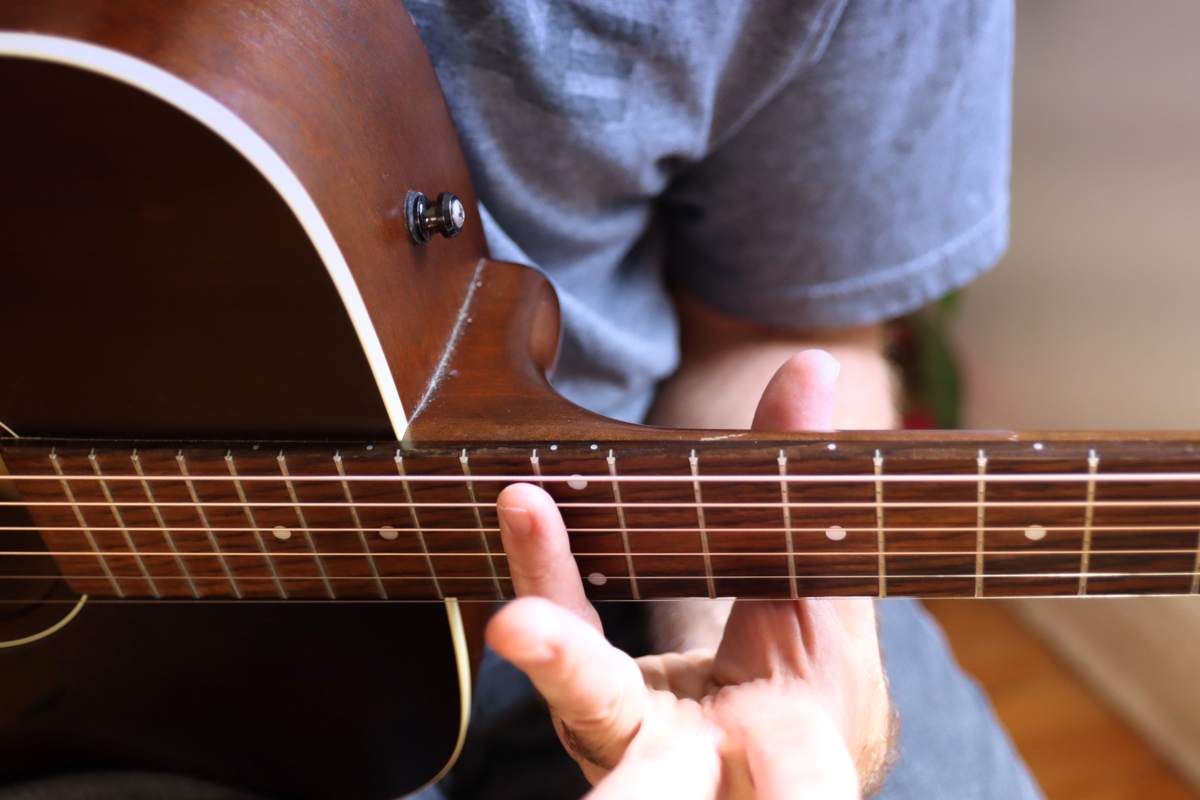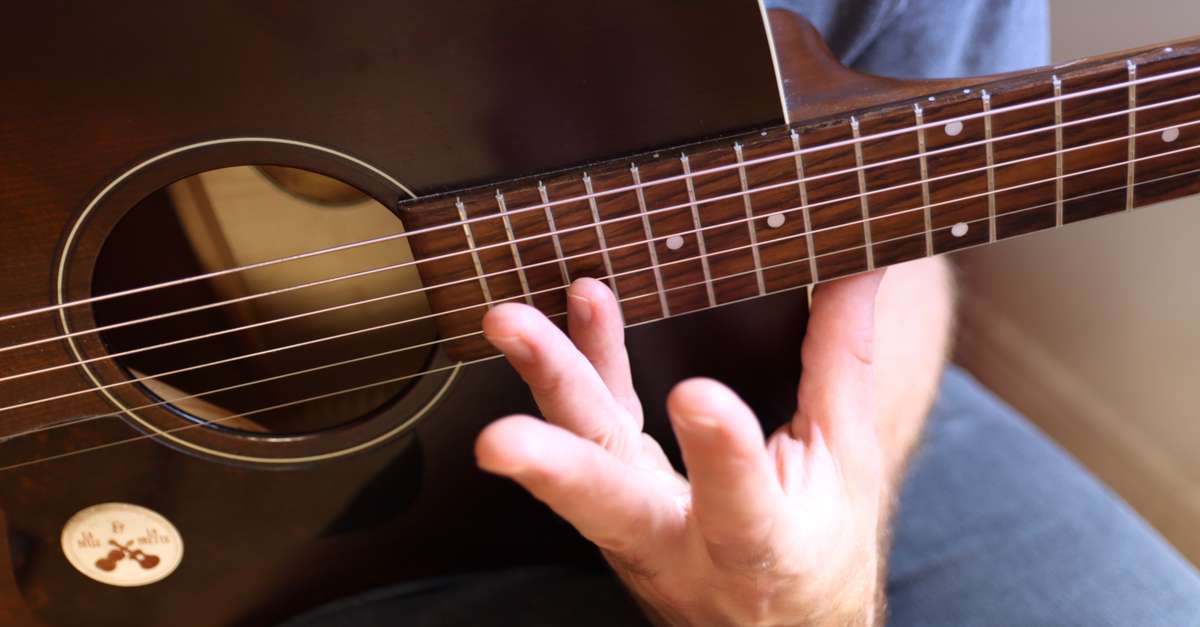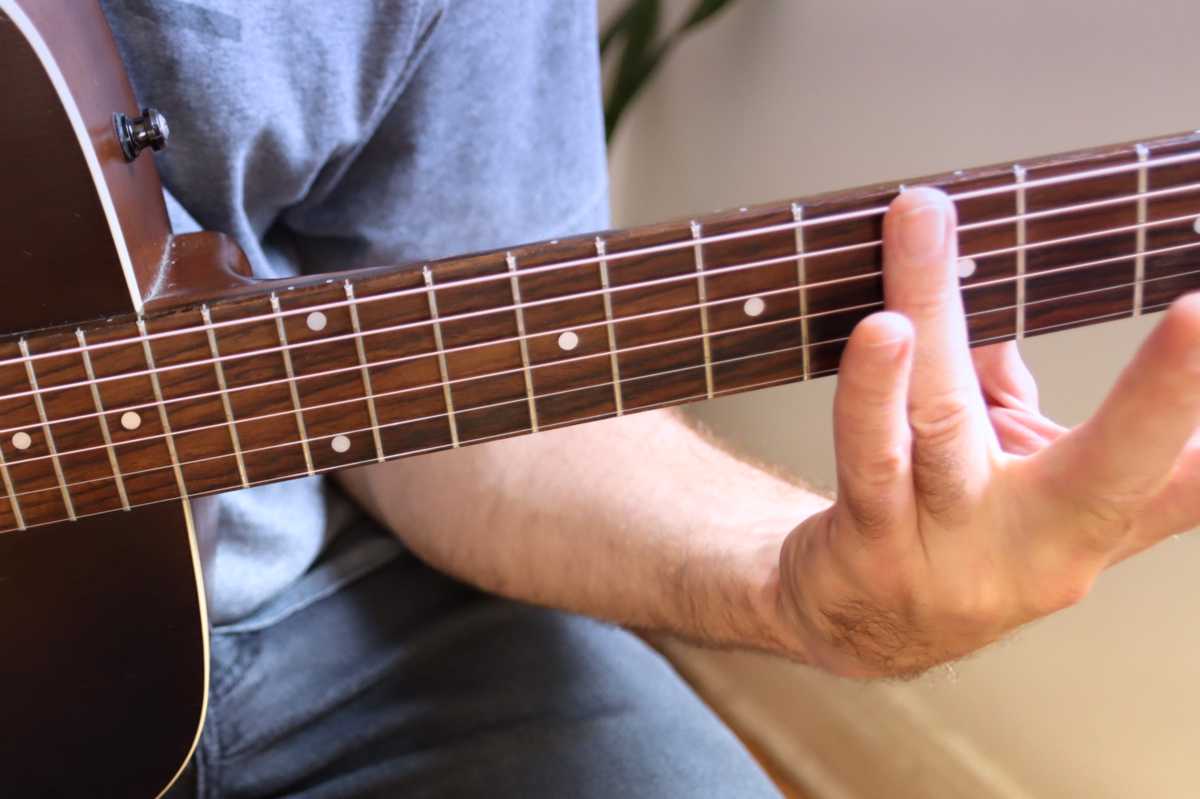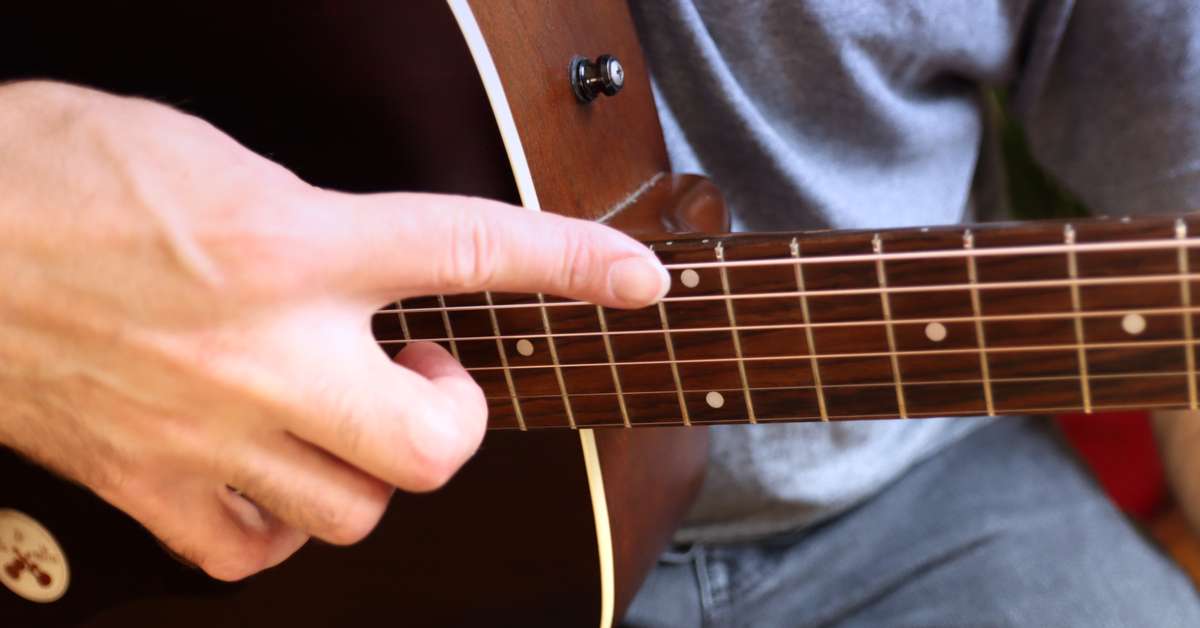Let's unlock the secrets of playing harmonics on the acoustic guitar with this comprehensive guide.
If you're struggling to get your harmonics on the guitar to sound right, it's probably due to this one simple thing that you can fix.
In fact, I used to struggle with playing harmonics as well, until I understood that with harmonics, it's all down to one thing: your finger location.
Get this wrong, and no matter how hard you try, nothing will work.
And to understand why this is the case, it helps to dive deep into learning what exactly makes guitar harmonics different from other ways to play the guitar.
I'll answer that and more in this in-depth guide to playing harmonics on the acoustic guitar.
- What Are Guitar Harmonics?
- How Do Harmonics Work On The Guitar?
- Do Harmonics Work On Every Fret?
- Why Can't I Play Guitar Harmonics?
- What Types Of Guitar Harmonics Can You Play in Fingerstyle Guitar?
- How To Play Artificial Harmonics On The Guitar
- How To Play Percussive Harmonics on Fingerstyle Guitar
- How Do You Read Guitar Harmonics?
- Are Guitar Harmonics Hard?
What Are Guitar Harmonics?
Before we dive into how to play guitar harmonics, have you ever wondered what makes an acoustic guitar sound different from another instrument, such as the piano?
In fact, I'm sure you can tell the difference between the classical guitar and the acoustic steel string dreadnought guitar just by listening, even if they are played in the same manner. Why is that?
The answer comes down to what is called timbre, which is a fancy word for "tone quality".
When we pluck a string on the guitar normally, the sound we hear is a combination of the fundamental frequency plus the overtones. The strength of these various overtone sounds is what constitutes the ‘timbre’ or what we would recognize as the “guitar sound”.
Similarly, we can change the timbre of our guitar by using harmonics.
When we isolate these harmonics and play them, the timbre is noticeably different than if we were to simply fret and pluck the note normally.
How Do Harmonics Work On The Guitar?
To produce a guitar harmonic, lightly place your finger on a node without applying pressure to push the string all the way down to the fretboard, then pluck the string.

If you pluck a guitar string and let it vibrate normally, the string vibrates along its whole length, from the bridge all the way to the nut. This is called the fundamental.
But when playing in the manner as described above, you will now hear a shimmering, bell-like sound called a guitar harmonic.
Also, instead of hearing the fundamental, you will hear a different note, depending on which node you touched.
Do Harmonics Work On Every Fret?
There are harmonics at the twelfth, seventh (or nineteenth) and fifth (or twenty-fourth) frets. However, most commonly we will use the harmonics at the twelfth fret.
The following chart shows the written notes that are produced from natural harmonics in standard tuning.
The notes on the 12th fret sound one octave higher than the open string, and the notes at the 7th (or 19th) fret will sound one octave and a fifth above the open string.
| Open String Note | Harmonic at 12th Fret | Harmonic at 7th (or 19th) Fret |
|---|---|---|
| E2 | E3 | B3 |
| A2 | A3 | E4 |
| D2 | D3 | A4 |
| G3 | G4 | D5 |
| B3 | B4 | F♯5 |
| E4 (high) | E5 | B5 |
The node for the second harmonic is located at the twelfth fret of the guitar.
The node which produces the third harmonic is located at both the seventh and the nineteenth frets. This harmonic sounds an octave and a fifth above the fundamental.

You may also use the fourth harmonic on some strings, which sounds two octaves above the open string. The node for this harmonic is located above the fifth fret, and also above the twenty-fourth fret. But since most acoustic guitars don't have that many frets, you have to use dead reckoning to find this node's location.
Do Harmonics Only Work On The 12th fret?
No, as we have seen, harmonics work well at the 7th and the 5th frets. In fact, there are harmonics that you can produce practically anywhere on the guitar. It's just that these harmonics are too faint to produce an audible sound, so we don't use them.
The easiest guitar harmonic to play can be found at the twelfth fret, or the midpoint of the string. Touching this node will produce a harmonic that sounds one octave above the fundamental, or the open string note.
The natural harmonic at the twelfth fret also produces the best harmonic sound: it is the easiest harmonic to get a loud, clear sound from your guitar. Unfortunately, not all harmonics are this easy to produce.
Why Can't I Play Guitar Harmonics?
The most common reason that your guitar harmonics aren't working is due to incorrect finger placement. In order to get the best sounding harmonics, precise finger placement is key. As well, you must immediately remove the finger that you used to touch the node after playing the harmonic, lest you muffle the string prematurely.
Unlike playing regular notes on the guitar, you must place your finger directly above the fret to produce the harmonic. This is in contrast to playing regular notes, where you place your finger between the frets.
Be precise when placing your finger on the node. Notice that the node is located exactly above the fret, not between or behind the fret. To easily play harmonics, count up the number frets from the fundamental to precisely locate your node.

In fact, if playing guitar normally were like walking down the street, playing harmonics becomes somewhat like a high-wire act. If you don't place your fingertip at the precise location, you will miss the mark entirely.
What Types Of Guitar Harmonics Can You Play in Fingerstyle Guitar?
In fingerstyle guitar, you can play natural harmonics, harp (or artificial) harmonics, and tap (percussive) harmonics. Pinch harmonics are generally not possible with fingerstyle guitar, unless you are using hybrid picking.
Harmonics are used in fingerstyle guitar to create a change in timbre to the normally plucked string. This can give an “unearthly” or "spaced-out" feel to the music. Alternatively, tap harmonics are an exciting way to add a burst of colour to your arrangement.
You can use harmonics to extend the high range of the guitar, which is helpful if you are playing a classical guitar which usually only has 19 frets.
By playing the third or fourth guitar harmonics over the fifth or seventh fret, you will play very high notes with harmonics in a lower fret position.
How To Play Artificial Harmonics On The Guitar
You may quickly find out that there are simply not enough variety in the natural harmonics that you can play on the guitar.
Luckily, to extend the harmonics available to us on the guitar beyond the ones in the table above, we can use a technique called artificial harmonics.
To play an artificial harmonic, stop a note with the fretting hand, and touch the node with a finger of the right hand whilst simultaneously plucking the string with another right hand finger (usually the thumb or ring finger).
This technique is sometimes called "harp harmonics". The index finger touches the node and the thumb or ring finger plucks the string.

Example: How To Play 'F' As a Harmonic
We will stop the note in the first fret on the first string, which is the note ‘f’. We need to calculate the midpoint of the string, which is the location of our octave harmonic.
We no longer touch the twelfth fret because we have effectively shortened the string by stopping it with the finger. Therefore, the midpoint of the string is one fret higher, and the second harmonic node is now located at the 13th fret.
You can combine other techniques with guitar harmonics to produce special effects on the guitar. The following techniques are taught in more detail in the online course Play Fingerstyle Guitar Now!
What Are Cascading Harmonics?
Cascading harmonics involve the mixing of natural or artificial harmonics with regular stopped notes or open strings. To play cascading harmonics, alternate playing artificial harmonics using the thumb and the index finger with a regular note plucked normally using the ring finger.
Pluck the harmonic note with the thumb and touch the node with the index finger. This leaves the other fingers free to pluck normal notes.
Tommy Emmanuel has popularized this technique. He will hold a chord with the left hand and arpeggiate across the strings, combining normally plucked notes with artificial harmonic notes.
How To Play Percussive Harmonics on Fingerstyle Guitar
You don't have to always pluck the string to produce harmonics, however. If you smash down with the flat part your finger at the node on an open string, this will cause the string to vibrate with harmonics.
Percussive harmonics give you an alternative from the delicate flute sound of plucked harmonics. With percussive harmonics, you get harmonics that sound at a louder volume.
Percussive harmonics are best produced using the second or third harmonics. Remember that the second harmonic is at the twelfth fret of the guitar and the third harmonic is at the seventh or the eighteenth fret.
How To Play Tap Harmonics on Fingerstyle Guitar
If you quickly tap a single string at the node and release or rebound with the fingertip, this will produce a sharp, percussive sound that includes lots of harmonics.
Another possibility is to tap the harmonics with the right hand, and then tap normal notes with the left hand. One effect that Sungha Jung uses is tap harmonics while he holds a chord. This produces a mixture of harmonic notes and regular sounding notes.
In all cases, you must be precise in where you tap the string if you want harmonics to sound. If need be, count up from the first fret and locate precisely the node that you want to hit. Both stopped notes and the capo can change the location of the node.
How Do You Read Guitar Harmonics?
Harmonics are notated with a diamond shaped notehead in standard notation. In tablature, the fret number where the node is located is written between chevrons, like this: <12>.
If you are playing artificial or harp harmonics, the fret number is notated first in the tab, followed by the fret where you need to touch the node. For example: 2<14> means you fret a note in the second fret and touch a node at the fourteenth fret.
Remember that harmonics other than the octave harmonic at the midpoint sound different from the fretted note. For example, if you play the note at the seventh fret on the first string, you will hear the note 'b'. But touching the node at this fret produces a harmonic that sounds a 'b' which is one octave higher than the fretted note.
Are Guitar Harmonics Hard?
I used to absolutely hate playing guitar harmonics and I would definitely say that playing guitar harmonics is an advanced technique. Moreover, it can be frustrating to try to figure out why your guitar harmonics just don't sound properly.
Guitar harmonics are one of those techniques you will need to learn in order to be able to play advanced fingerstyle guitar. These techniques are covered in detail in my online course Play Fingerstyle Guitar Now!



